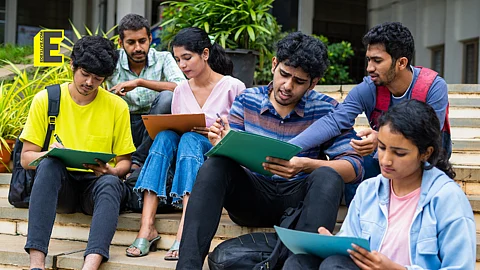
- News
- Campus
- Exam
- Podcast
- Web Stories
- Do You Know
- Path Finders - UG Programs
- Videos
- Book Review

The National Education Policy (NEP) has brought about many major changes in India's education landscape, but the Multiple Entry/Exit System (MEES) is at its core. MEES is believed to be a significant pillar of help to socially and economically disadvantaged students.
Students can drop their course and resume it at any time through MEES.
For instance, if a student cannot continue their studies due to financial strain, they can leave the course temporarily until they earn enough money for her tuition.
MEES, therefore, is an opportunity for financially challenged students to complete their studies at their own pace.
Generally, in India, dropouts in higher education happen for multiple reasons, including but not limited to economic, social, familial, religious, and other factors.
Let's understand with another example: MEES would be a boon to students who suffer from critical illnesses, or girls who get married early, or are pregnant while pursuing a degree.
However, a thorough analysis of this concept reveals an attempt to shift education from a social responsibility to a personal responsibility, accompanied by numerous practical complications.
Apart from its benefits, there is a significant risk that MEES will legitimise student dropouts.
According to the latest trends, the dropout rate in higher education in India has decreased considerably over the past few decades, although the enrollment rate remains at only 26 per cent.
The issue is that MEES has no provision to ensure students' resumption after their exit. Therefore, only those who return voluntarily will benefit from the multiple-entry option.
Otherwise, it validates the postponement of education for trivial reasons, as many will naturally tend to do.
The implementation of MEES may come with numerous complications for educational institutions.
One significant problem would be determining the number of students admitted each year.
For example, a college takes 30 students annually for a degree programme. Suppose 10 students exit by the second semester, and about 20 students who dropped out years ago want to resume studies. In that case, it will upset the teacher-pupil ratio and the infrastructural facilities available.
Naturally, the number of students likely to resume their studies each year is restricted.
Therefore, students would not be able to join according to their will, but rather according to the institution's availability, as per MEES.
Additionally, multiple-entry admission in government colleges and universities can be given only by following the reservation policy.
Currently, numerous scholarships are available to assist students with their higher education.
However, it will be a reasonable justification to withdraw all such scholarships with the general belief that students can study on their own
